run flat Hyundai Accent 2003 Owner's Manual
[x] Cancel search | Manufacturer: HYUNDAI, Model Year: 2003, Model line: Accent, Model: Hyundai Accent 2003Pages: 186, PDF Size: 11.36 MB
Page 107 of 186
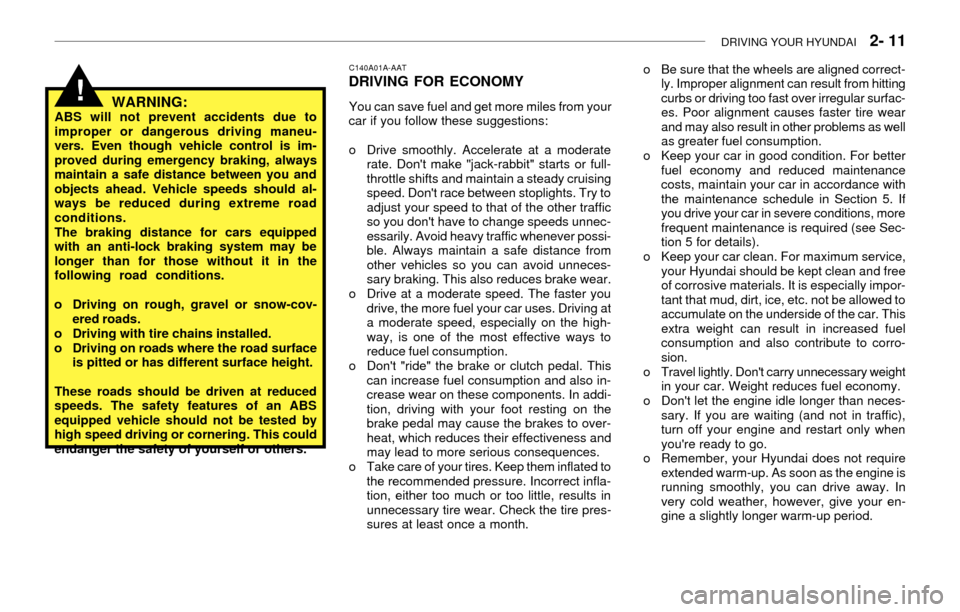
DRIVING YOUR HYUNDAI 2- 11
WARNING:ABS will not prevent accidents due to
improper or dangerous driving maneu-
vers. Even though vehicle control is im-
proved during emergency braking, always
maintain a safe distance between you and
objects ahead. Vehicle speeds should al-
ways be reduced during extreme road
conditions.
The braking distance for cars equipped
with an anti-lock braking system may be
longer than for those without it in the
following road conditions.
o Driving on rough, gravel or snow-cov-
ered roads.
o Driving with tire chains installed.
o Driving on roads where the road surface
is pitted or has different surface height.
These roads should be driven at reduced
speeds. The safety features of an ABS
equipped vehicle should not be tested by
high speed driving or cornering. This could
endanger the safety of yourself or others.
!
C140A01A-AATDRIVING FOR ECONOMY
You can save fuel and get more miles from your
car if you follow these suggestions:
o Drive smoothly. Accelerate at a moderate
rate. Don't make "jack-rabbit" starts or full-
throttle shifts and maintain a steady cruising
speed. Don't race between stoplights. Try to
adjust your speed to that of the other traffic
so you don't have to change speeds unnec-
essarily. Avoid heavy traffic whenever possi-
ble. Always maintain a safe distance from
other vehicles so you can avoid unneces-
sary braking. This also reduces brake wear.
o Drive at a moderate speed. The faster you
drive, the more fuel your car uses. Driving at
a moderate speed, especially on the high-
way, is one of the most effective ways to
reduce fuel consumption.
o Don't "ride" the brake or clutch pedal. This
can increase fuel consumption and also in-
crease wear on these components. In addi-
tion, driving with your foot resting on the
brake pedal may cause the brakes to over-
heat, which reduces their effectiveness and
may lead to more serious consequences.
o Take care of your tires. Keep them inflated to
the recommended pressure. Incorrect infla-
tion, either too much or too little, results in
unnecessary tire wear. Check the tire pres-
sures at least once a month.o Be sure that the wheels are aligned correct-
ly. Improper alignment can result from hitting
curbs or driving too fast over irregular surfac-
es. Poor alignment causes faster tire wear
and may also result in other problems as well
as greater fuel consumption.
o Keep your car in good condition. For better
fuel economy and reduced maintenance
costs, maintain your car in accordance with
the maintenance schedule in Section 5. If
you drive your car in severe conditions, more
frequent maintenance is required (see Sec-
tion 5 for details).
o Keep your car clean. For maximum service,
your Hyundai should be kept clean and free
of corrosive materials. It is especially impor-
tant that mud, dirt, ice, etc. not be allowed to
accumulate on the underside of the car. This
extra weight can result in increased fuel
consumption and also contribute to corro-
sion.
o Travel lightly. Don't carry unnecessary weight
in your car. Weight reduces fuel economy.
o Don't let the engine idle longer than neces-
sary. If you are waiting (and not in traffic),
turn off your engine and restart only when
you're ready to go.
o Remember, your Hyundai does not require
extended warm-up. As soon as the engine is
running smoothly, you can drive away. In
very cold weather, however, give your en-
gine a slightly longer warm-up period.
Page 114 of 186
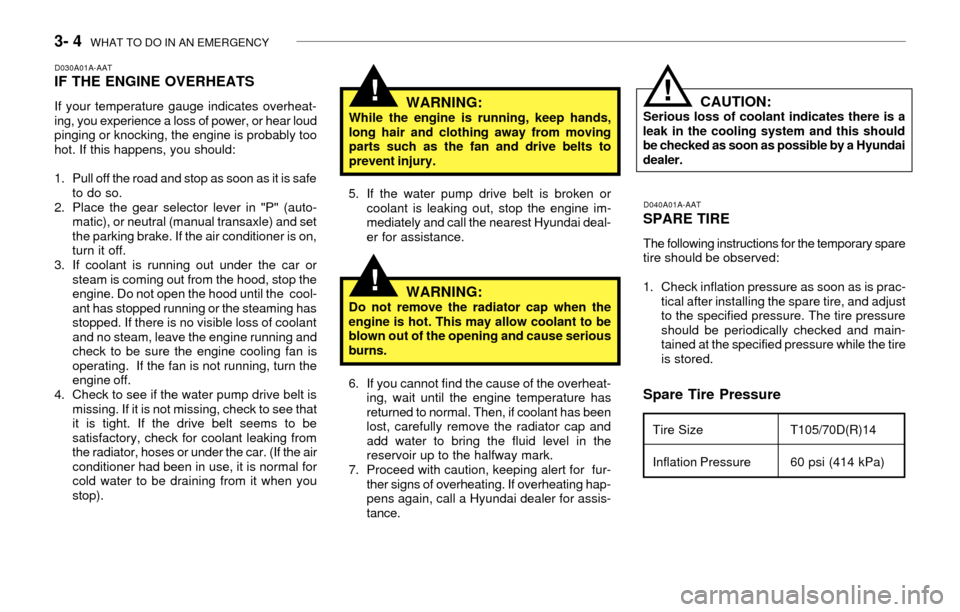
3- 4 WHAT TO DO IN AN EMERGENCY
WARNING:While the engine is running, keep hands,
long hair and clothing away from moving
parts such as the fan and drive belts to
prevent injury.
Spare Tire Pressure
D040A01A-AAT
SPARE TIRE
The following instructions for the temporary spare
tire should be observed:
1. Check inflation pressure as soon as is prac-
tical after installing the spare tire, and adjust
to the specified pressure. The tire pressure
should be periodically checked and main-
tained at the specified pressure while the tire
is stored.
D030A01A-AATIF THE ENGINE OVERHEATS
If your temperature gauge indicates overheat-
ing, you experience a loss of power, or hear loud
pinging or knocking, the engine is probably too
hot. If this happens, you should:
1. Pull off the road and stop as soon as it is safe
to do so.
2. Place the gear selector lever in "P" (auto-
matic), or neutral (manual transaxle) and set
the parking brake. If the air conditioner is on,
turn it off.
3. If coolant is running out under the car or
steam is coming out from the hood, stop the
engine. Do not open the hood until the cool-
ant has stopped running or the steaming has
stopped. If there is no visible loss of coolant
and no steam, leave the engine running and
check to be sure the engine cooling fan is
operating. If the fan is not running, turn the
engine off.
4. Check to see if the water pump drive belt is
missing. If it is not missing, check to see that
it is tight. If the drive belt seems to be
satisfactory, check for coolant leaking from
the radiator, hoses or under the car. (If the air
conditioner had been in use, it is normal for
cold water to be draining from it when you
stop).5. If the water pump drive belt is broken or
coolant is leaking out, stop the engine im-
mediately and call the nearest Hyundai deal-
er for assistance.
WARNING:Do not remove the radiator cap when the
engine is hot. This may allow coolant to be
blown out of the opening and cause serious
burns.
6. If you cannot find the cause of the overheat-
ing, wait until the engine temperature has
returned to normal. Then, if coolant has been
lost, carefully remove the radiator cap and
add water to bring the fluid level in the
reservoir up to the halfway mark.
7. Proceed with caution, keeping alert for fur-
ther signs of overheating. If overheating hap-
pens again, call a Hyundai dealer for assis-
tance.
CAUTION:Serious loss of coolant indicates there is a
leak in the cooling system and this should
be checked as soon as possible by a Hyundai
dealer.
!
!
!
Tire Size
Inflation PressureT105/70D(R)14
60 psi (414 kPa)
Page 117 of 186
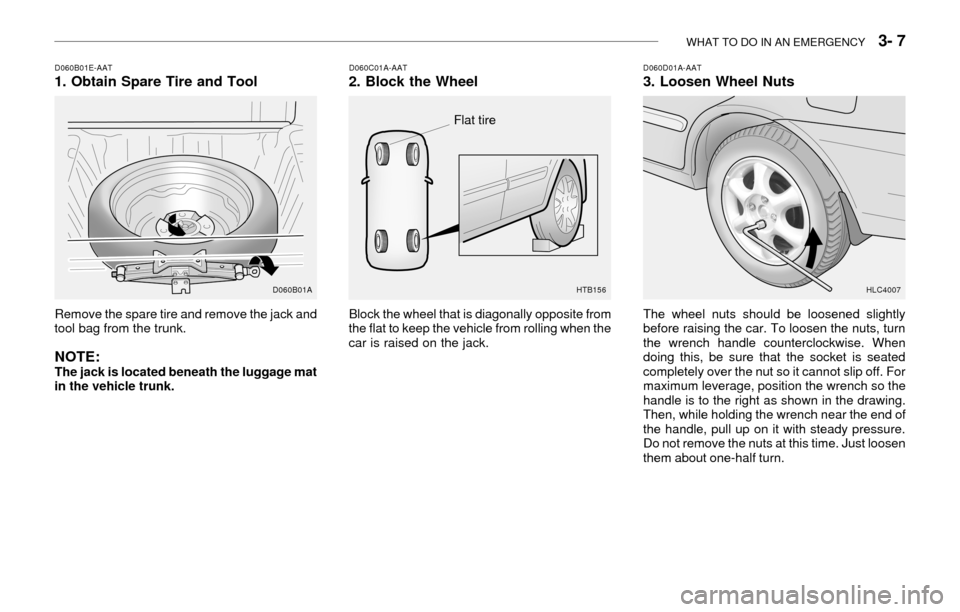
WHAT TO DO IN AN EMERGENCY 3- 7
Remove the spare tire and remove the jack and
tool bag from the trunk.
NOTE:The jack is located beneath the luggage mat
in the vehicle trunk.
D060B01E-AAT1. Obtain Spare Tire and Tool
D060B01AHTB156
Flat tire
Block the wheel that is diagonally opposite from
the flat to keep the vehicle from rolling when the
car is raised on the jack.
D060C01A-AAT2. Block the WheelD060D01A-AAT3. Loosen Wheel Nuts
The wheel nuts should be loosened slightly
before raising the car. To loosen the nuts, turn
the wrench handle counterclockwise. When
doing this, be sure that the socket is seated
completely over the nut so it cannot slip off. For
maximum leverage, position the wrench so the
handle is to the right as shown in the drawing.
Then, while holding the wrench near the end of
the handle, pull up on it with steady pressure.
Do not remove the nuts at this time. Just loosen
them about one-half turn.
HLC4007
Page 120 of 186
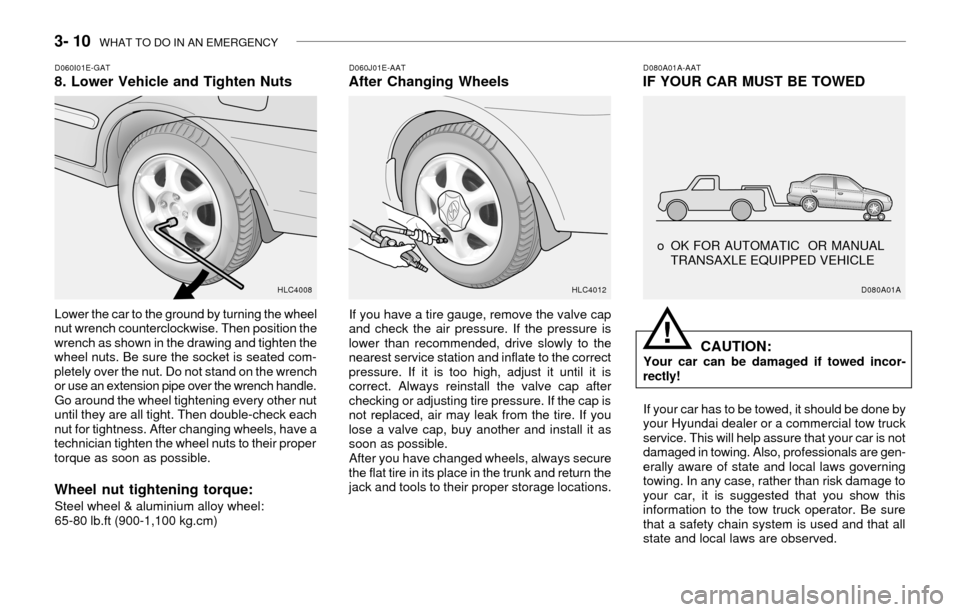
3- 10 WHAT TO DO IN AN EMERGENCY
D060I01E-GAT8. Lower Vehicle and Tighten Nuts
Lower the car to the ground by turning the wheel
nut wrench counterclockwise. Then position the
wrench as shown in the drawing and tighten the
wheel nuts. Be sure the socket is seated com-
pletely over the nut. Do not stand on the wrench
or use an extension pipe over the wrench handle.
Go around the wheel tightening every other nut
until they are all tight. Then double-check each
nut for tightness. After changing wheels, have a
technician tighten the wheel nuts to their proper
torque as soon as possible.
Wheel nut tightening torque:
Steel wheel & aluminium alloy wheel:
65-80 lb.ft (900-1,100 kg.cm)
D060J01E-AATAfter Changing Wheels
If you have a tire gauge, remove the valve cap
and check the air pressure. If the pressure is
lower than recommended, drive slowly to the
nearest service station and inflate to the correct
pressure. If it is too high, adjust it until it is
correct. Always reinstall the valve cap after
checking or adjusting tire pressure. If the cap is
not replaced, air may leak from the tire. If you
lose a valve cap, buy another and install it as
soon as possible.
After you have changed wheels, always secure
the flat tire in its place in the trunk and return the
jack and tools to their proper storage locations.
D080A01A-AATIF YOUR CAR MUST BE TOWED
CAUTION:
Your car can be damaged if towed incor-
rectly!
HLC4008HLC4012
If your car has to be towed, it should be done by
your Hyundai dealer or a commercial tow truck
service. This will help assure that your car is not
damaged in towing. Also, professionals are gen-
erally aware of state and local laws governing
towing. In any case, rather than risk damage to
your car, it is suggested that you show this
information to the tow truck operator. Be sure
that a safety chain system is used and that all
state and local laws are observed.
D080A01A
o OK FOR AUTOMATIC OR MANUAL
TRANSAXLE EQUIPPED VEHICLE
!
Page 161 of 186
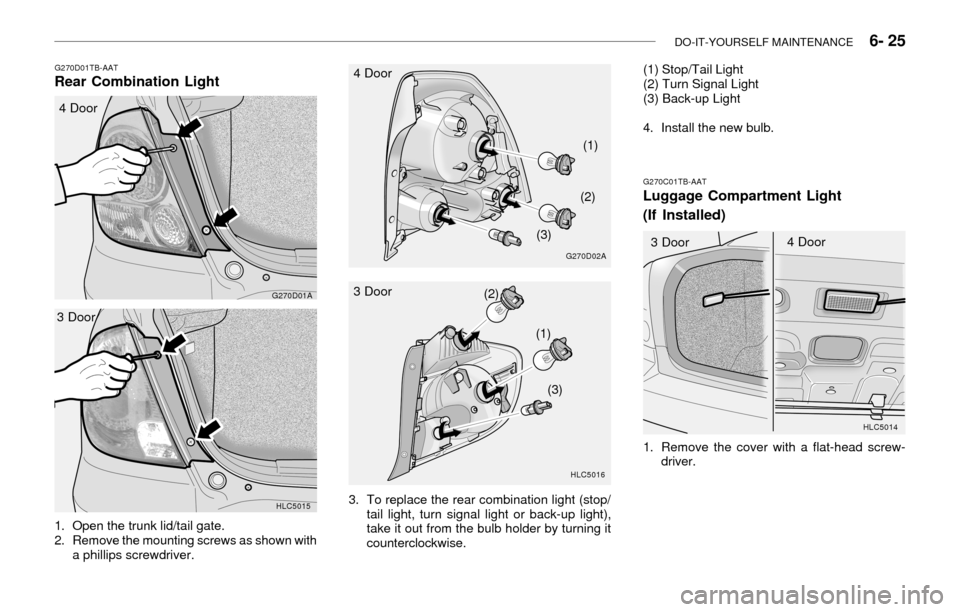
DO-IT-YOURSELF MAINTENANCE 6- 25
G270D01TB-AATRear Combination Light
HLC5015
3 Door
G270D01A
4 Door
1. Open the trunk lid/tail gate.
2. Remove the mounting screws as shown with
a phillips screwdriver.3. To replace the rear combination light (stop/
tail light, turn signal light or back-up light),
take it out from the bulb holder by turning it
counterclockwise.(2)
(1)
(3)
G270C01TB-AATLuggage Compartment Light
(If Installed)
HLC5014
1. Remove the cover with a flat-head screw-
driver. 3 Door4 Door
HLC5016
3 Door
G270D02A
4 Door
(1)
(2)
(3)(1) Stop/Tail Light
(2) Turn Signal Light
(3) Back-up Light
4. Install the new bulb.
Page 185 of 186
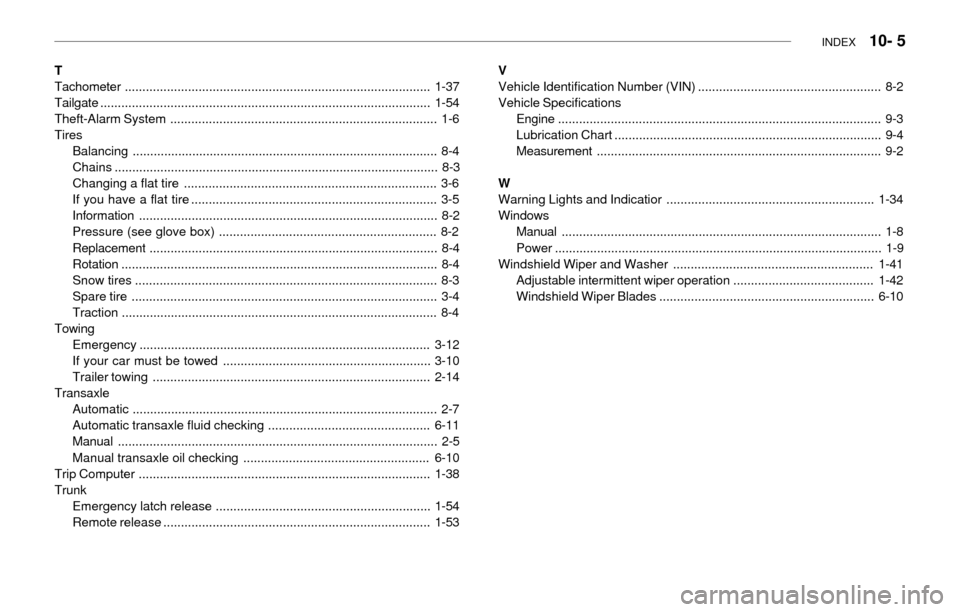
INDEX 10- 5
T
Tachometer.......................................................................................1-37
Tailgate..............................................................................................1-54
Theft-Alarm System ............................................................................ 1-6
Tires
Balancing ....................................................................................... 8-4
Chains ............................................................................................ 8-3
Changing a flat tire ........................................................................ 3-6
If you have a flat tire ...................................................................... 3-5
Information..................................................................................... 8-2
Pressure (see glove box) .............................................................. 8-2
Replacement.................................................................................. 8-4
Rotation.......................................................................................... 8-4
Snow tires ...................................................................................... 8-3
Spare tire ....................................................................................... 3-4
Traction .......................................................................................... 8-4
Towing
Emergency ...................................................................................3-12
If your car must be towed ...........................................................3-10
Trailer towing ...............................................................................2-14
Transaxle
Automatic ....................................................................................... 2-7
Automatic transaxle fluid checking ..............................................6-11
Manual........................................................................................... 2-5
Manual transaxle oil checking .....................................................6-10
Trip Computer ...................................................................................1-38
Trunk
Emergency latch release .............................................................1-54
Remote release ............................................................................1-53V
Vehicle Identification Number (VIN) .................................................... 8-2
Vehicle Specifications
Engine............................................................................................ 9-3
Lubrication Chart ............................................................................ 9-4
Measurement................................................................................. 9-2
W
Warning Lights and Indicatior ...........................................................1-34
Windows
Manual........................................................................................... 1-8
Power ............................................................................................. 1-9
Windshield Wiper and Washer .........................................................1-41
Adjustable intermittent wiper operation ........................................1-42
Windshield Wiper Blades .............................................................6-10
Page 186 of 186
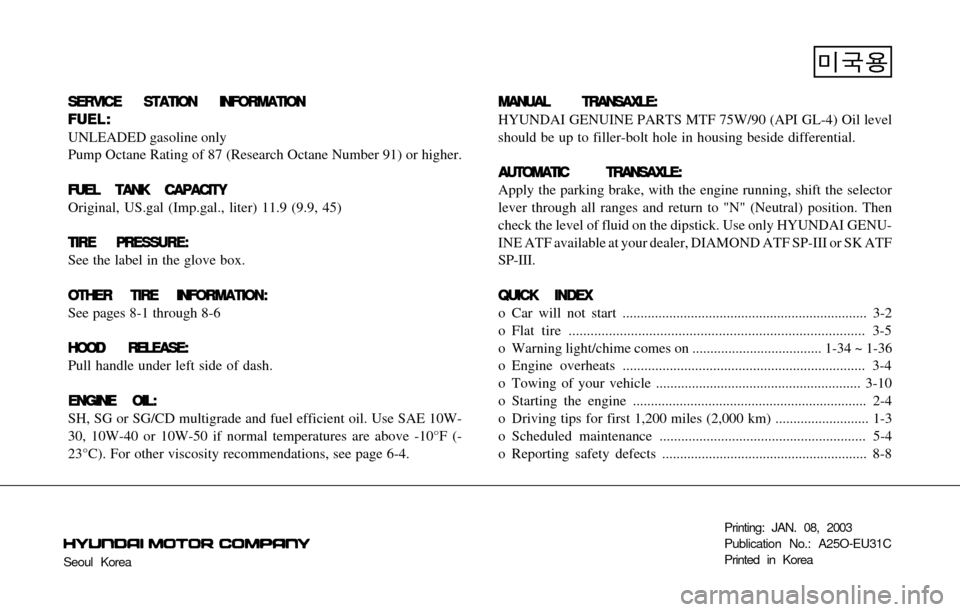
Seoul KoreaPrinting: JAN. 08, 2003
Publication No.: A25O-EU31C
Printed in Korea
SERVICE STATION INFORMATION SERVICE STATION INFORMATIONSERVICE STATION INFORMATION SERVICE STATION INFORMATION
SERVICE STATION INFORMATION
FUEL: FUEL:FUEL: FUEL:
FUEL:
UNLEADED gasoline only
Pump Octane Rating of 87 (Research Octane Number 91) or higher.
FUEL TANK CAPACITY FUEL TANK CAPACITYFUEL TANK CAPACITY FUEL TANK CAPACITY
FUEL TANK CAPACITY
Original, US.gal (Imp.gal., liter) 11.9 (9.9, 45)
TIRE PRESSURE: TIRE PRESSURE:TIRE PRESSURE: TIRE PRESSURE:
TIRE PRESSURE:
See the label in the glove box.
OTHER TIRE INFORMATION: OTHER TIRE INFORMATION:OTHER TIRE INFORMATION: OTHER TIRE INFORMATION:
OTHER TIRE INFORMATION:
See pages 8-1 through 8-6
HOOD RELEASE: HOOD RELEASE:HOOD RELEASE: HOOD RELEASE:
HOOD RELEASE:
Pull handle under left side of dash.
ENGINE OIL: ENGINE OIL:ENGINE OIL: ENGINE OIL:
ENGINE OIL:
SH, SG or SG/CD multigrade and fuel efficient oil. Use SAE 10W-
30, 10W-40 or 10W-50 if normal temperatures are above -10°F (-
23°C). For other viscosity recommendations, see page 6-4.MANUAL TRANSAXLE: MANUAL TRANSAXLE:MANUAL TRANSAXLE: MANUAL TRANSAXLE:
MANUAL TRANSAXLE:
HYUNDAI GENUINE PARTS MTF 75W/90 (API GL-4) Oil level
should be up to filler-bolt hole in housing beside differential.
AUTOMATIC TRANSAXLE: AUTOMATIC TRANSAXLE:AUTOMATIC TRANSAXLE: AUTOMATIC TRANSAXLE:
AUTOMATIC TRANSAXLE:
Apply the parking brake, with the engine running, shift the selector
lever through all ranges and return to "N" (Neutral) position. Then
check the level of fluid on the dipstick. Use only HYUNDAI GENU-
INE ATF available at your dealer, DIAMOND ATF SP-III or SK ATF
SP-III.
QUICK INDEX QUICK INDEXQUICK INDEX QUICK INDEX
QUICK INDEX
o Car will not start .................................................................... 3-2
o Flat tire ................................................................................. 3-5
o Warning light/chime comes on .................................... 1-34 ~ 1-36
o Engine overheats ................................................................... 3-4
o Towing of your vehicle ......................................................... 3-10
o Starting the engine ................................................................. 2-4
o Driving tips for first 1,200 miles (2,000 km) .......................... 1-3
o Scheduled maintenance ......................................................... 5-4
o Reporting safety defects ......................................................... 8-8